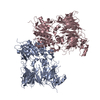+ Open data
Open data
- Basic information
Basic information
| Entry | Database: PDB / ID: 7jkq | ||||||
|---|---|---|---|---|---|---|---|
| Title | Human DPP9-CARD8 complex | ||||||
 Components Components |
| ||||||
 Keywords Keywords |  IMMUNE SYSTEM / IMMUNE SYSTEM /  HYDROLASE / CARD8 / HYDROLASE / CARD8 /  DPP9 / DPP9 /  inflammasome / Val-boroPro (VbP) / talabostat / inflammasome / Val-boroPro (VbP) / talabostat /  innate immunity innate immunity | ||||||
| Function / homology |  Function and homology information Function and homology informationCARD8 inflammasome complex assembly /  NACHT domain binding / Formation of apoptosome / cysteine-type endopeptidase activator activity / inhibition of cysteine-type endopeptidase activity / negative regulation of NLRP3 inflammasome complex assembly / NACHT domain binding / Formation of apoptosome / cysteine-type endopeptidase activator activity / inhibition of cysteine-type endopeptidase activity / negative regulation of NLRP3 inflammasome complex assembly /  NLRP3 inflammasome complex / NLRP3 inflammasome complex /  dipeptidyl-peptidase IV / dipeptidyl-peptidase IV /  CARD domain binding / negative regulation of lipopolysaccharide-mediated signaling pathway ...CARD8 inflammasome complex assembly / CARD domain binding / negative regulation of lipopolysaccharide-mediated signaling pathway ...CARD8 inflammasome complex assembly /  NACHT domain binding / Formation of apoptosome / cysteine-type endopeptidase activator activity / inhibition of cysteine-type endopeptidase activity / negative regulation of NLRP3 inflammasome complex assembly / NACHT domain binding / Formation of apoptosome / cysteine-type endopeptidase activator activity / inhibition of cysteine-type endopeptidase activity / negative regulation of NLRP3 inflammasome complex assembly /  NLRP3 inflammasome complex / NLRP3 inflammasome complex /  dipeptidyl-peptidase IV / dipeptidyl-peptidase IV /  CARD domain binding / negative regulation of lipopolysaccharide-mediated signaling pathway / self proteolysis / dipeptidyl-peptidase activity / Regulation of the apoptosome activity / negative regulation of programmed cell death / CARD domain binding / negative regulation of lipopolysaccharide-mediated signaling pathway / self proteolysis / dipeptidyl-peptidase activity / Regulation of the apoptosome activity / negative regulation of programmed cell death /  Hydrolases; Acting on peptide bonds (peptidases) / regulation of canonical NF-kappaB signal transduction / Hydrolases; Acting on peptide bonds (peptidases) / regulation of canonical NF-kappaB signal transduction /  pattern recognition receptor activity / negative regulation of interleukin-1 beta production / negative regulation of NF-kappaB transcription factor activity / pyroptotic inflammatory response / cell leading edge / cysteine-type endopeptidase activator activity involved in apoptotic process / antiviral innate immune response / positive regulation of cysteine-type endopeptidase activity involved in apoptotic process / negative regulation of tumor necrosis factor-mediated signaling pathway / negative regulation of canonical NF-kappaB signal transduction / pattern recognition receptor activity / negative regulation of interleukin-1 beta production / negative regulation of NF-kappaB transcription factor activity / pyroptotic inflammatory response / cell leading edge / cysteine-type endopeptidase activator activity involved in apoptotic process / antiviral innate immune response / positive regulation of cysteine-type endopeptidase activity involved in apoptotic process / negative regulation of tumor necrosis factor-mediated signaling pathway / negative regulation of canonical NF-kappaB signal transduction /  aminopeptidase activity / serine-type peptidase activity / molecular condensate scaffold activity / positive regulation of interleukin-1 beta production / aminopeptidase activity / serine-type peptidase activity / molecular condensate scaffold activity / positive regulation of interleukin-1 beta production /  peptidase activity / regulation of apoptotic process / defense response to virus / peptidase activity / regulation of apoptotic process / defense response to virus /  microtubule / protein homodimerization activity / protein-containing complex / microtubule / protein homodimerization activity / protein-containing complex /  proteolysis / proteolysis /  nucleoplasm / identical protein binding / nucleoplasm / identical protein binding /  nucleus / nucleus /  cytosol / cytosol /  cytoplasm cytoplasmSimilarity search - Function | ||||||
| Biological species |   Homo sapiens (human) Homo sapiens (human) | ||||||
| Method |  ELECTRON MICROSCOPY / ELECTRON MICROSCOPY /  single particle reconstruction / single particle reconstruction /  cryo EM / Resolution: 3.3 Å cryo EM / Resolution: 3.3 Å | ||||||
 Authors Authors | Sharif, H. / Hollingsworth, L.R. | ||||||
| Funding support |  United States, 1items United States, 1items
| ||||||
 Citation Citation |  Journal: Immunity / Year: 2021 Journal: Immunity / Year: 2021Title: Dipeptidyl peptidase 9 sets a threshold for CARD8 inflammasome formation by sequestering its active C-terminal fragment. Authors: Humayun Sharif / L Robert Hollingsworth / Andrew R Griswold / Jeffrey C Hsiao / Qinghui Wang / Daniel A Bachovchin / Hao Wu /  Abstract: CARD8 detects intracellular danger signals and forms a caspase-1 activating inflammasome. Like the related inflammasome sensor NLRP1, CARD8 autoprocesses into noncovalently associated N-terminal (NT) ...CARD8 detects intracellular danger signals and forms a caspase-1 activating inflammasome. Like the related inflammasome sensor NLRP1, CARD8 autoprocesses into noncovalently associated N-terminal (NT) and C-terminal (CT) fragments and binds the cellular dipeptidyl peptidases DPP8 and 9 (DPP8/9). Certain danger-associated signals, including the DPP8/9 inhibitor Val-boroPro (VbP) and HIV protease, induce proteasome-mediated NT degradation and thereby liberate the inflammasome-forming CT. Here, we report cryoelectron microscopy (cryo-EM) structures of CARD8 bound to DPP9, revealing a repressive ternary complex consisting of DPP9, full-length CARD8, and CARD8-CT. Unlike NLRP1-CT, CARD8-CT does not interact with the DPP8/9 active site and is not directly displaced by VbP. However, larger DPP8/9 active-site probes can directly weaken this complex in vitro, and VbP itself nevertheless appears to disrupt this complex, perhaps indirectly, in cells. Thus, DPP8/9 inhibitors can activate the CARD8 inflammasome by promoting CARD8 NT degradation and by weakening ternary complex stability. | ||||||
| History |
|
- Structure visualization
Structure visualization
| Movie |
 Movie viewer Movie viewer |
|---|---|
| Structure viewer | Molecule:  Molmil Molmil Jmol/JSmol Jmol/JSmol |
- Downloads & links
Downloads & links
- Download
Download
| PDBx/mmCIF format |  7jkq.cif.gz 7jkq.cif.gz | 376.4 KB | Display |  PDBx/mmCIF format PDBx/mmCIF format |
|---|---|---|---|---|
| PDB format |  pdb7jkq.ent.gz pdb7jkq.ent.gz | 299.9 KB | Display |  PDB format PDB format |
| PDBx/mmJSON format |  7jkq.json.gz 7jkq.json.gz | Tree view |  PDBx/mmJSON format PDBx/mmJSON format | |
| Others |  Other downloads Other downloads |
-Validation report
| Arichive directory |  https://data.pdbj.org/pub/pdb/validation_reports/jk/7jkq https://data.pdbj.org/pub/pdb/validation_reports/jk/7jkq ftp://data.pdbj.org/pub/pdb/validation_reports/jk/7jkq ftp://data.pdbj.org/pub/pdb/validation_reports/jk/7jkq | HTTPS FTP |
|---|
-Related structure data
| Related structure data |  22367MC  7jn7C M: map data used to model this data C: citing same article ( |
|---|---|
| Similar structure data | |
| EM raw data |  EMPIAR-10597 (Title: Human DPP9-CARD8 complex / Data size: 1.6 TB EMPIAR-10597 (Title: Human DPP9-CARD8 complex / Data size: 1.6 TBData #1: Unaligned multi frame micographs of CARD8-DPP9-noTILT [micrographs - multiframe] Data #2: Unaligned multi frame micographs of CARD8-DPP9-apo-TILT [micrographs - multiframe]) |
- Links
Links
- Assembly
Assembly
| Deposited unit | 
|
|---|---|
| 1 |
|
- Components
Components
| #1: Protein |  / DP9 / Dipeptidyl peptidase IV-related protein 2 / DPRP-2 / Dipeptidyl peptidase IX / DPP IX / ...DP9 / Dipeptidyl peptidase IV-related protein 2 / DPRP-2 / Dipeptidyl peptidase IX / DPP IX / Dipeptidyl peptidase-like protein 9 / DPLP9 / DPP9 / DP9 / Dipeptidyl peptidase IV-related protein 2 / DPRP-2 / Dipeptidyl peptidase IX / DPP IX / ...DP9 / Dipeptidyl peptidase IV-related protein 2 / DPRP-2 / Dipeptidyl peptidase IX / DPP IX / Dipeptidyl peptidase-like protein 9 / DPLP9 / DPP9Mass: 98384.320 Da / Num. of mol.: 2 Source method: isolated from a genetically manipulated source Source: (gene. exp.)   Homo sapiens (human) / Gene: DPP9, DPRP2 / Cell line (production host): HEK293 / Production host: Homo sapiens (human) / Gene: DPP9, DPRP2 / Cell line (production host): HEK293 / Production host:   Homo sapiens (human) / References: UniProt: Q86TI2, Homo sapiens (human) / References: UniProt: Q86TI2,  dipeptidyl-peptidase IV dipeptidyl-peptidase IV#2: Protein | Mass: 60716.875 Da / Num. of mol.: 2 Source method: isolated from a genetically manipulated source Source: (gene. exp.)   Homo sapiens (human) / Gene: CARD8, KIAA0955, NDPP1 / Cell line (production host): HEK293 / Production host: Homo sapiens (human) / Gene: CARD8, KIAA0955, NDPP1 / Cell line (production host): HEK293 / Production host:   Homo sapiens (human) / References: UniProt: Q9Y2G2 Homo sapiens (human) / References: UniProt: Q9Y2G2 |
|---|
-Experimental details
-Experiment
| Experiment | Method:  ELECTRON MICROSCOPY ELECTRON MICROSCOPY |
|---|---|
| EM experiment | Aggregation state: PARTICLE / 3D reconstruction method:  single particle reconstruction single particle reconstruction |
- Sample preparation
Sample preparation
| Component | Name: DPP9-CARD8 complex / Type: COMPLEX / Entity ID: all / Source: RECOMBINANT |
|---|---|
| Source (natural) | Organism:   Homo sapiens (human) Homo sapiens (human) |
| Source (recombinant) | Organism:   Homo sapiens (human) / Cell: HEK293 / Plasmid Homo sapiens (human) / Cell: HEK293 / Plasmid : pcDNA3.1 : pcDNA3.1 |
| Buffer solution | pH: 7.5 / Details: 25mM HEPES, pH 7.5, 150 mM NaCl, 1 mM TCEP |
| Specimen | Conc.: 0.5 mg/ml / Embedding applied: NO / Shadowing applied: NO / Staining applied : NO / Vitrification applied : NO / Vitrification applied : YES : YES |
| Specimen support | Grid material: COPPER / Grid type: Quantifoil R1.2/1.3 |
Vitrification | Instrument: FEI VITROBOT MARK IV / Cryogen name: ETHANE / Humidity: 100 % / Chamber temperature: 278 K |
- Electron microscopy imaging
Electron microscopy imaging
| Experimental equipment |  Model: Titan Krios / Image courtesy: FEI Company | |||||||||||||||
|---|---|---|---|---|---|---|---|---|---|---|---|---|---|---|---|---|
| Microscopy | Model: FEI TITAN KRIOS | |||||||||||||||
| Electron gun | Electron source : OTHER / Accelerating voltage: 300 kV / Illumination mode: SPOT SCAN : OTHER / Accelerating voltage: 300 kV / Illumination mode: SPOT SCAN | |||||||||||||||
| Electron lens | Mode: OTHER / Calibrated magnification: 10500 X / Nominal defocus max: 2200 nm / Nominal defocus min: -800 nm / Cs : 2.7 mm : 2.7 mm | |||||||||||||||
| Specimen holder | Specimen holder model: FEI TITAN KRIOS AUTOGRID HOLDER | |||||||||||||||
| Image recording | Imaging-ID: 1 / Film or detector model: GATAN K3 BIOQUANTUM (6k x 4k) / Num. of grids imaged: 4
|
- Processing
Processing
| Software | Name: PHENIX / Version: 1.18.2_3874: / Classification: refinement | ||||||||||||||||||||||||||||||||||||
|---|---|---|---|---|---|---|---|---|---|---|---|---|---|---|---|---|---|---|---|---|---|---|---|---|---|---|---|---|---|---|---|---|---|---|---|---|---|
| EM software |
| ||||||||||||||||||||||||||||||||||||
CTF correction | Type: PHASE FLIPPING AND AMPLITUDE CORRECTION | ||||||||||||||||||||||||||||||||||||
| Symmetry | Point symmetry : C1 (asymmetric) : C1 (asymmetric) | ||||||||||||||||||||||||||||||||||||
3D reconstruction | Resolution: 3.3 Å / Resolution method: FSC 0.143 CUT-OFF / Num. of particles: 120998 / Algorithm: FOURIER SPACE / Num. of class averages: 1 / Symmetry type: POINT | ||||||||||||||||||||||||||||||||||||
| Atomic model building | Protocol: OTHER | ||||||||||||||||||||||||||||||||||||
| Atomic model building | PDB-ID: 6EOQ Pdb chain-ID: A / Accession code: 6EOQ / Source name: PDB / Type: experimental model | ||||||||||||||||||||||||||||||||||||
| Refine LS restraints |
|
 Movie
Movie Controller
Controller





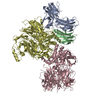
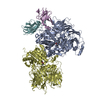
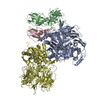

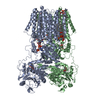
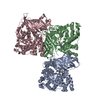
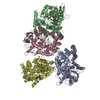

 PDBj
PDBj





